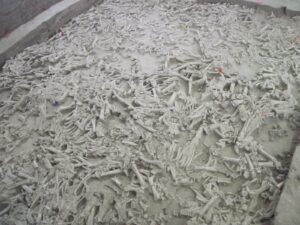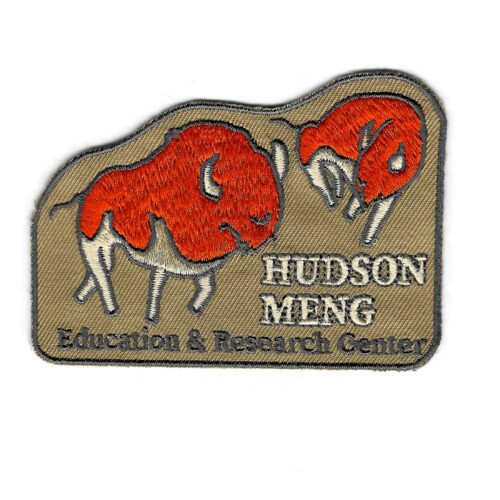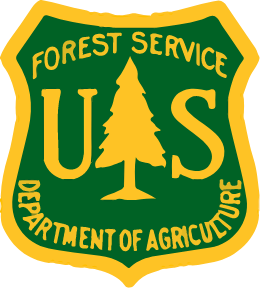Quick Facts:
- Huson-Meng’s 2025 season has ended as of Labor Day Weekend. Plan your 2026 visit or learn more below….
- Best Time to Visit: Open Fridays only from Memorial Day weekend to Labor Day weekend, 9:00 AM – 4:30 PM.
- Where: Hudson-Meng Bison Site, 20 miles northwest of Crawford, Nebraska, in the Oglala National Grassland.
- Why Visit: See an ancient bison bonebed and learn about prehistoric life on the Great Plains.
- Top Activities:
- Guided tours with knowledgeable staff
- Interactive exhibits and fossil displays
- Hands-on activities and junior archaeologist programs for kids
- Nearby Attractions: Combine your visit with a hike at Toadstool Geologic Park or a trip to Agate Fossil Beds National Monument.
- Make it Easy: Climate-controlled visitor center, picnic areas, and restrooms available.
- Support the Site: Your site store purchases and donations help preserve this unique archaeological treasure.

Hudson Meng is a great way to see an active archaeology site in a climate controlled environment. Great for a stop on a hot day. USFS photo
Northwestern Nebraska hides a prehistoric treasure. The Hudson-Meng Bison Site sits in the striking Oglala National Grassland. It’s one of North America’s most important paleo-archaeological discoveries. Here, hundreds of ancient bison remains tell a 10,000-year-old story. Visitors can step back in time at this unique site. Unravel the mysteries of life on the ancient Great Plains. For families on a road trip, Hudson-Meng offers an unforgettable journey into prehistory.
Hudson-Meng is just 20 miles northwest of Crawford, Nebraska. It’s a perfect stop on your road trip between the Black Hills, Scotts Bluff, and I-80. This site is more than just a bonebed. It’s a gateway to ancient history. Here, you’ll explore thousands of years of human-bison relationships. The preserved excavation site is truly awe-inspiring. It brings together paleontology, archaeology, and human discovery. Your family will stand at the crossroads of science and history.
Historical Significance
The story of Hudson-Meng begins in 1954 when two local ranchers, Albert Meng and Bill Hudson, made an accidental discovery that would capture the imagination of scientists for decades to come. While digging a stock pond, they unearthed something extraordinary—a vast collection of bones. Little did they know that their chance finding would lead to one of the most important archaeological sites in North America.
In 1968, professional archaeologists led by Dr. Larry Agenbroad began to uncover the true magnitude of the discovery. What they found was astounding: the remains of up to 600 bison dating back approximately 10,000 years. These were Bison antiquus, an extinct species larger than modern bison and a crucial link in the evolutionary chain between ancient and contemporary bison species.
The importance of Hudson-Meng to both paleontology and archaeology cannot be overstated. It represents one of the largest and best-preserved Paleoindian sites in North America, offering invaluable insights into the lives of both ancient bison and the early humans who inhabited this region. The site has become a cornerstone in our understanding of Great Plains ecology, climate change, and human adaptation during the transition from the Pleistocene to the Holocene epoch.
The Mystery of the Hudson-Meng Bison
Perhaps the most captivating aspect of Hudson-Meng is the enduring mystery surrounding the fate of these ancient bison. How did hundreds of these massive creatures come to rest in this single location? This question has sparked decades of scientific debate and continues to fuel ongoing research at the site. This is one of the few federal land management sites where the trail wayside signs and displays in the visitor center are deliberately designed to be quickly and easily updated with new scientific discoveries.
Initially, archaeologists believed Hudson-Meng to be a “kill site”—a place where Paleoindian hunters had driven a large herd of bison to their deaths, possibly over a cliff or into a natural trap. This theory was supported by the discovery of stone tools and projectile points among the bones, indicating human presence and activity.
However, subsequent research in the 1990s challenged this interpretation. Some scientists proposed that the bison might have died from natural causes such as disease, drought, or wildfire, with humans later scavenging the remains. The lack of clear cut marks on many bones and the unusual preservation of complete skeletons added weight to this alternative explanation. After all, if the bison were being deliberately hunted for food and supplies, large portions of the animal would have been removed for transport to camp or village.
More recent excavations have uncovered evidence of multiple human occupations at the site over hundreds of years, suggesting a complex history of human-bison interactions. The presence of different types of projectile points, including both Cody and Eden points, indicates that various groups of Paleoindians visited and used the site over an extended period.
This ongoing debate makes Hudson-Meng a fascinating case study in archaeological interpretation. It demonstrates how new evidence and evolving scientific methods can reshape our understanding of the past. As a visitor, you’re not just observing history—you’re witnessing the dynamic process of scientific inquiry in action.
Join BHPFA as a member to support all our amazing Black Hills and Western Nebraska partners!
Educational Value

Bone beds may look like a jumbled mess, but each bone tells scientists an important story. Wikimedia photo
A visit to Hudson-Meng offers an unparalleled educational experience. Here, visitors of all ages can gain insights into:
- The biology and behavior of ancient bison species
- The lifeways of Paleoindian cultures, including their hunting techniques and tool-making skills
- The methods and challenges of modern archaeological research
- The changing climate and ecology of the Great Plains over millennia
- The process of fossilization and the preservation of ancient remains
The site serves as a living laboratory, demonstrating how scientists piece together clues from the distant past to reconstruct ancient ecosystems and human societies. It’s a place where the abstract concepts of geological time and biological evolution become tangible, offering visitors a profound sense of connection to the Earth’s history.
For students, educators, and road-tripping lifelong learners, Hudson-Meng provides a unique opportunity to engage with primary archaeological evidence. The ability to see an active excavation site and examine real fossils and artifacts in their original context is an experience that simply can’t be replicated in a classroom or traditional museum setting. And it’s not an experience likely to be replicated anywhere else on your family’s travels.
Visitor Experience at the Hudson-Meng Bison Site
When you visit Hudson-Meng, you’ll be greeted by a modern, climate-controlled enclosure that protects the main excavation area. This structure allows year-round viewing of the bonebed while safeguarding the delicate remains from the elements.
Guided Tours
Guided tours, led by knowledgeable USDA Forest Service staff, bring the site to life with in-depth explanations of the fossils, artifacts, and ongoing research. These tours provide a comprehensive overview of the site’s history, significance, and the various theories about its formation.

Family-Friendly Features
For families, interactive tours and hands-on activities engage children and make the visit both fun and educational. Kids can participate in scavenger hunts, “junior archaeologist” programs (funded by your BHPFA purchases, memberships, and donations!), and other activities designed to spark their curiosity and enhance their understanding of the past.
Visitor Center
The visitor center features interpretive exhibits that contextualize the bonebed within the broader story of Great Plains prehistory. Here, you can examine replica artifacts, learn about Paleoindian cultures, and gain a deeper understanding of the scientific methods used to study the site.
The Bison Trail
For the more adventurous, the Bison Trail offers a memorable three-mile hike connecting Hudson-Meng to the nearby Toadstool Geologic Park. This trail provides stunning views of the Oglala National Grassland and allows visitors to experience the landscape much as it would have appeared thousands of years ago.
Hudson-Meng is more than just a standalone attraction—it’s part of a rich network of prehistoric sites in the region: Nebraska’s own “Fossil Highway.” Nearby attractions include Toadstool Geologic Park, known for its otherworldly rock formations and abundant fossils, and Agate Fossil Beds National Monument, which preserves an important Miocene epoch fossil site. Together, these sites offer a comprehensive journey through millions of years of Earth’s history.
Current Operating Hours
Important Note: Due to staffing reductions across the U.S. Forest Service, Hudson-Meng Education and Research Center is currently open only during the summer season from Memorial Day weekend through Labor Day weekend. Operating hours are limited to Fridays ONLY from 9:00 AM to 4:30 PM.
We strongly encourage visitors to plan their trips accordingly!. If you’re planning a visit, please double-check the current schedule on the official USDA Forest Service website or social media channels as hours may be subject to change. While we wish longer hours were possible, current funding and staffing levels limit the Forest Service’s ability to remain open year-round or for additional days during the season.
Hudson-Meng Needs Your Support
The Hudson-Meng Bison Site represents an irreplaceable piece of North America’s natural and cultural heritage. Its preservation and continued study are crucial for advancing our understanding of ancient ecosystems, climate change, and human prehistory. However, maintaining and operating a site of this importance requires significant resources.
Moreover, increased funding could support additional research at the site. Despite decades of study, Hudson-Meng still holds many secrets. Continued excavation and analysis could yield new insights into Paleoindian life, ancient bison ecology, and climate change on the Great Plains. Your support of Hudson-Meng through BHPFA can help unlock these mysteries and contribute to our collective understanding of North America’s prehistoric past.
Support Hudson-Meng by shopping our online store, or browse the visitor center store when you stop by!
How to Support Hudson-Meng
The Black Hills Parks and Forests Association plays a crucial role in supporting Hudson-Meng and other important sites in the region. As a non-profit cooperating association, BHPFA operates the visitor center store at Hudson-Meng with proceeds directly supporting site operations, educational programs, and research efforts.
There are several ways you can contribute to the preservation and enhancement of Hudson-Meng:
- Make a direct donation to BHPFA earmarked for Hudson-Meng
- Become a BHPFA member to provide ongoing support
- Purchase items from the visitor center store either on-site or online
- Spread the word about Hudson-Meng to friends, family, and on social media
Your contributions, no matter the size, make a real difference. They help fund essential maintenance, support educational programs, and could potentially allow for extended operating hours in the future. Every donation or store purchase brings us one step closer to fully realizing Hudson-Meng’s potential as a year-round center for education and research.
Join us in preserving this unique piece of North American heritage. Together, we can keep the story of Hudson-Meng alive and accessible for future generations of visitors, students, and researchers. Your support today helps safeguard our understanding of yesterday and informs our path to tomorrow.
Want to earmark your donation to Hudson-Meng? Write it in the comments!




